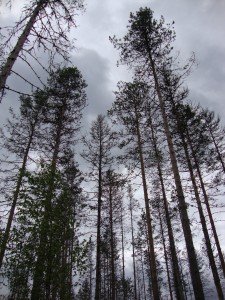 Methods for detecting and monitoring of damage by forest herbivores under changing climate are needed. Our study species are two serious defoliators, the European sawfly (Neodiprion sertifer Geoff.) and the Common pine sawfly (Diprion pini L.). Needle consumption by the pine sawflies severely affects forest health. Economic impacts include growth loss and even tree mortality. Our main focus has been on D. pini that has recently turned into a significant forest pest in Finland and caused remarkable defoliation of Scots pine (Pinus sylvestris L.).
Methods for detecting and monitoring of damage by forest herbivores under changing climate are needed. Our study species are two serious defoliators, the European sawfly (Neodiprion sertifer Geoff.) and the Common pine sawfly (Diprion pini L.). Needle consumption by the pine sawflies severely affects forest health. Economic impacts include growth loss and even tree mortality. Our main focus has been on D. pini that has recently turned into a significant forest pest in Finland and caused remarkable defoliation of Scots pine (Pinus sylvestris L.).
 In our Palokangas study area, eastern Finland, the population has been at gradation and postgradation level for over ten years enabling a rare opportunity to monitor a high population density for a long time period. Our data include large scale field inventory, cocoon sampling, pheromone trapping, as well as remote sensing. For example, based on cocoon sampling and field data, we suggest that natural enemies have a high controlling impact on D. pini population, and hence defoliation intensity. We also observed a clear impact of forest floor vegetation on parasitism and predation potential. We also have studied methods of utilizing LiDAR point clouds (Light Detection and Ranging) for tree- and plot-wise needle loss estimations. We suggest that LiDAR can be suitable for detection of needle losses at coarse level, which is sufficient for early warnings. Further, our activities include investigation of suitability of inventory methods in mapping insect damage. Our results indicate that adaptive cluster sampling is a considerable method for mapping of these typically scattered and clustered phenomena. Future plans include nation- and continent-wide projections of pine sawfly distributions as a consequence of the climate change.
In our Palokangas study area, eastern Finland, the population has been at gradation and postgradation level for over ten years enabling a rare opportunity to monitor a high population density for a long time period. Our data include large scale field inventory, cocoon sampling, pheromone trapping, as well as remote sensing. For example, based on cocoon sampling and field data, we suggest that natural enemies have a high controlling impact on D. pini population, and hence defoliation intensity. We also observed a clear impact of forest floor vegetation on parasitism and predation potential. We also have studied methods of utilizing LiDAR point clouds (Light Detection and Ranging) for tree- and plot-wise needle loss estimations. We suggest that LiDAR can be suitable for detection of needle losses at coarse level, which is sufficient for early warnings. Further, our activities include investigation of suitability of inventory methods in mapping insect damage. Our results indicate that adaptive cluster sampling is a considerable method for mapping of these typically scattered and clustered phenomena. Future plans include nation- and continent-wide projections of pine sawfly distributions as a consequence of the climate change.
